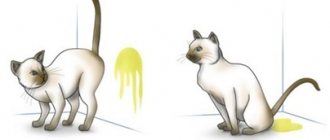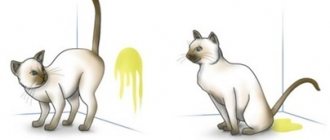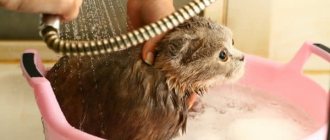The article has been revised and certified
Dobrovolskaya Daria Vyacheslavovna
student of veterinary medicine LNUVM and BT named after. S. Z. Grzhitsky
Ask a Question
Many cat owners have to deal with territory marking. For cats, this behavior is a way of communication, but for people it is a real disaster, (or even a whole disaster), because of which, unfortunately, the cat can be surrendered to a shelter or even euthanized.
You are probably wondering: how to quickly and effectively deal with this problem? We'll come back to this later, but first, let's make sure that we all understand correctly why cats spray liquid?
Sometimes by marking their territory, cats try to draw your attention to the problem.
Why is this happening
Leaving special marks should not be confused with normal urination. If in the second case the animal relieves itself naturally in a specially designated place (tray), then marking the territory is a special ritual with the help of which the fluffy wants to say that he is the owner here. As a rule, purrs choose any furniture, walls, interior or entrance door, flower pots, etc. for this purpose. Animals living outside leave “marks” on tree trunks, bushes, plants, and fences. Do not rush to scold a cat for bad behavior; he is guided by instincts, genetics and a self-preservation mechanism.
Representatives of the feline genus have an excellent sense of smell; the odors left behind serve as a clear, readable identifier of the individual. But it’s one thing when a cat marks territory, what if a cat does it? This also happens, although much less frequently; the female also leaves her “calling cards”, marking the boundaries of her zone, declaring who is in charge in the house. Animals, being under stress, strive to protect themselves from outside encroachment and imaginary enemies.
Why does a neutered cat continue to mark?
Reasons why a neutered pet does not stop marking:
- Habit. A castrated cat can continue to “play pranks” for several months after the operation, because a certain amount of hormones remain in the animal’s blood for some time, which push the pet to such actions. In this case, you need to be patient and wait a little.
- Wildness and experience of marks. If the animal is used to living on the street and was neutered at over a year of age, then the bad habit may persist for another 2-3 months after the operation. As the concentration of hormones in the blood decreases, the cat’s behavior normalizes and he stops marking.
- Cryptorchidism. It happens that an animal’s testicles develop incorrectly, and one of them does not descend into the scrotum. When performing castration, the doctor can only remove what is available to him. In this case, one testicle remains in the abdominal cavity, which provokes the appearance of marks after the operation. If a cat is diagnosed with cryptorchidism, then castration should not be carried out in the standard way, but using direct access - an incision in the abdominal cavity.
- Presence of other animals. Fear, jealousy, and switching attention to other pets can contribute to the appearance of marks in already neutered cats.
- Diseases of the urinary system. Cystitis, pyelonephritis, the presence of kidney stones - all these factors can provoke the resumption of a bad habit in a pet after surgery.
If there are several cats in the house, then the likelihood that the pet will continue to mark increases
Attention! If after castration you give your pet enough attention and show him your love and care, then the risk of resuming the harmful habit of releasing a stream of urine in the wrong place is reduced several times.
Reasons for marking territory after castration - video
When do the first cat marks appear?
For the first time, owners are faced with the problem of how to wean a cat from marking territory in the house after six months, by which time the fluffies become sexually mature. The onset of this period depends on the breed:
- large individuals (ragdoll, maine coon) - closer to 12 months;
- British - by 8 months;
- Siamese - by 5-6 months.
Personality, genetic predisposition, home environment, the presence of other pets and other factors matter. In some cases, you may be lucky and the question of how to wean a cat from marking will not become relevant. If the animal has a calm character, puberty occurs without incident, you may not see any odorous traces on interior items, doors or walls.
How to wean your pet from the habit of marking
Unfortunately, it is almost impossible to wean an animal from the habit of marking territory. Many people think that if you constantly scold a cat or rub his nose into a crime scene, he will stop doing it. Not only will the listed options not help, but they will also aggravate the situation, since during times of stress the pet will mark even more actively.
Scolding a cat is a dubious method that can only make the situation worse
The optimal method is castration. In this case, the habit will go away over time as the activity of the sex glands decreases. The operation is performed under general anesthesia and is considered minimally invasive and harmless to the pet. The cat’s body recovers quickly, and after 8–12 weeks the pet completely forgets about the habit of marking. In this case, both testicles are removed from the animal using a miniature incision in the scrotum area. The surgical suture heals quickly, and the cat returns to his normal life within 1–2 weeks.
After castration, a cat stops marking and becomes calmer
In addition to castration, you can try lavender oil. It not only scares the cat away from the crime scene, but also prevents the appearance of new marks. Essential oil can be applied in concentrated form to the place where the animal most often misbehaves. It is also recommended to add a few drops to a bucket of water when cleaning floors.
To treat already marked corners, you can use a cotton pad to thoroughly rub in the oil. As the ether wears off, the procedure can be repeated, but over time this need disappears, because the cat loses interest in the event in the presence of a pungent odor.
Lavender essential oil is unpleasant for cats
To rid your pet of a bad habit, you can also try Ecoprom spray “Does not crap, does not mark.” This product has a specific odor that is neutral for people, but unpleasant for cats. Before spraying the spray, it is necessary to thoroughly rinse the areas where the animal most often shits. Treatment should be carried out 2 times a day until the pet stops marking the territory.
Spray Ecoprom “Doesn’t shit, doesn’t mark” allows you to wean your cat from the habit of mischief in the wrong place
Attention! Many experts advise influencing your pet psychologically in order to permanently wean him off the bad habit. To do this, it is recommended to take the cat by the withers with your hand and raise it to eye level, making sounds like a hiss, and lightly hit the ears with the other palm, thereby showing who is boss in the house. Adherents of this method believe that in this way the animal will cease to consider itself the main one in the territory. However, such actions will instill in the pet distrust of the owner and fears, which will only aggravate the situation.
How often do cats leave marks?
Here everything is individual, if females mark only during estrus, males can dirty the apartment all year round (usually in spring and autumn), causing significant inconvenience and discomfort to the owners.
On average, the frequency of leaving urine marks is about 2-3 per day, and “quiet periods” may be observed. But, unfortunately, it also happens that a purr marks at least 10 times in just one day. Here you need to decide what to do to prevent the cat from marking immediately.
Reasons that make cats mark territory
When buying a kitten, it is difficult to understand how it will behave in adulthood. In some cases, he behaves correctly, and only the tray has to be cleaned, and in others he shows who is boss in the house, even if he has never marked the territory before. Typically, this problem occurs in most cases when the pet is 7 months old and wants a female. However, even after achieving your goal, the problem of marking vertical surfaces and things often remains relevant.
Many animal owners solve the problem of excessive sexual activity by castration.
Its essence is to remove the animal’s genital organs (testicles). The procedure is performed mainly at a young age (up to 12 months) under local or general anesthesia. It lasts no more than 15 minutes, after which the pet can be taken home. Such operations are something scary for many owners, but with their help the pet becomes more obedient. Veterinarians recommend carrying them out before the first mating, so that the cat does not mark in the apartment with virtually 100% probability.
Surgery performed to remove the testicles can be performed at any age, but in the case of an adult, problems may occur.
The pet has already developed certain habits over the years of its life. It will no longer be possible to wean him from such a harmful process in any other way . However, it has been observed more than once how even a neutered cat marks its territory within 1-3 months after surgery. Experts believe that the reason for this phenomenon lies in the remaining hormones. Hormonal levels stabilize only over time, so you need to be patient.
Fluffy marks things and shoes with urine
What should you do if your cat marks everywhere, including shoes and even clothes? Surely you were not prepared for such a development of events when you got a pet.
The fact is that the imperious purr does not care where his scent marks will be; the main goal is to inform competitors and surrounding people that there is no place for a stranger in this territory. As for shoes, they exude the aroma of human body and sweat. The animal will try in every way to drown out extraneous odors, replacing the aromatic bouquet of shoes that is unacceptable to it with urine marks.
Why does a cat mark things and shoes?
The cat marks things and shoes, following natural instinct, because the main purpose of the tracks is to convey information about itself to other individuals, to let them know that the territory is occupied. The animal doesn’t care what object it urinates on – a tree or the owner’s expensive leather bag.
As for shoes, shoes, boots, sneakers are saturated with the smell of the environment, the street. According to animal psychologists, a cat marks shoes to drown out someone else's smell with its own and spread its scent over a large area.
Animal marks a person
In certain cases, formed behavioral instincts force the cat to urinate on the owner. In this way, the purr declares its rights, making you a member of the imaginary cat clan. On the one hand, you should be proud that you are accepted as one of their own, on the other hand, this is unacceptable and everything must be done to stop the cat from marking the apartment and you.
It also happens that a cat perceives its owner as a competitor; this is especially typical for animals that were picked up on the street at puberty. Fuzzies, obeying natural instinct, continue to fight for themselves, mistaking you for a competitor.
New pet in the house
Cats have natural instincts, so the presence of other animals in the house can affect their behavior. The pet will begin to mark the corners of the apartment as proof that he is the owner, even if castration was carried out shortly before.
It is extremely problematic to wean a cat from marking objects without driving out another animal. Sometimes you even have to divide the territory between them. Only the owner’s attention and time can help here. Gradually, the pet will get used to the new neighbor and stop being mischievous . There is no point in punishing him and shouting for his misdeeds. This behavior will only aggravate the situation, especially if it concerns an adult cat.
© shutterstock
Where do cats mark most often?
Despite the strong, unpleasant aroma of cat urine, it is not easy to find the specific place where the little villain urinated. Typically, the crime scene is walls, cabinet fronts, furniture, a refrigerator, wallpaper, the owner’s clothes or shoes, or another pet’s sleeping place.
Some fluffies choose unusual, hard-to-reach places that a good sense of smell is not enough to identify. A UV lamp or flashlight with LED beams will help in the search; traces of urine are highlighted with a bright yellowish-neon spot.
How to find cat marks
You can find cat marks in your favorite places: animals most often leave marks on walls, wallpaper, furniture, shoes, and clothes. A specific smell will lead to a “crime scene.”
However, some individuals manage to mark territory in hard-to-reach places, complicating timely detection. In this case, an ultraviolet lamp will come to the rescue. A light source with a wavelength of 365-385 nm or a flashlight with an LED lamp will help identify traces of cat urine. It is best to search for tags in the dark. When illuminated with a lamp or flashlight, cat urine appears as a glowing yellow, greenish neon stain.
This is what cat marks look like under a lamp
Prevention or how to stop a cat from marking in the house in advance
Uncastrated animals begin their “dirty deeds” no earlier than six months of age; until this period, living together with a kitten will not cause inconvenience. Problems begin after reaching sexual maturity, at which time the male’s leadership qualities begin to appear. Unfortunately, it is not possible to prevent the development of natural changes in the body.
At the same time, it is necessary to pay attention to the education of the animal:
- show your child who is boss in the house, do not allow permissiveness;
- pay attention to the fluffy, do not leave him alone for a long time;
- Make sure your cat has toys and play with him.
Do not use force against the cat under any circumstances, do not show aggression, do not throw objects at it, do not raise your voice. Harsh parenting methods will provoke an aggressive reaction, the purr will mark more diligently, thereby trying to protect itself. The only effective preventive measure is competent education and timely hygiene measures.
Lack of attention
Cats, like other domestic animals, need human affection and care. If you don’t show it towards them, then the reaction will be appropriate. Pets will begin to attract the attention of their owner. To do this, they can mark interior items. Pets especially often try to leave their mark on the door .
Solving the problem of attention deficit is quite simple. To do this, you actually don’t need to do anything except devote more time to your pet. Most of all, cats love to be played with, communicated with and petted. You need to devote at least 5 minutes to this process several times a day. The pet will gradually begin to understand that the owner loves him and will stop being mischievous.
© shutterstock
What to do if your cat marks
The peak of “activity” occurs in the autumn-autumn period, this is explained by hormonal changes in the cat’s body. Zoologists associate the strengthening of sexual instincts with an increase in the duration of daylight hours, as well as the peculiarities of the biological rhythm of the animal.
In search of an answer to the question of what to do to prevent a cat from marking, owners are trying non-standard solutions. One of these can be called keeping an animal during an “exacerbation” in a darkened room. If the “irreparable” has already happened, it is necessary to clean the stained area, thoroughly wash the furniture and walls, apply a disinfectant and repellent spray.
Veterinarians do not recommend using detergents containing bleach; bleach vapors are dangerous for people and animals. Regular baking soda, a weak solution of vinegar, or special products that neutralize the pungent odor of urine will do.
At worst, if you don’t have a special spray on hand, you can use aromatic oils, eau de toilette, incense sticks, perfume or air freshener.
Why does a cat mark its owner?
According to experienced breeders, the reason why a cat marks its owner is natural behavioral instincts - in this way the cat lays claim to the owner, showing other relatives (even hypothetical ones) that the owner is a member of his clan.
Some scientists believe that this behavior of the animal is due to the fact that the cat perceives the owner as a competitor. Adult males picked up from the street are most often predisposed to this style of communication. Animals are accustomed to fighting for survival and perceive any living object as hostile.
How to remove traces of urine in an apartment
Even when you have decided what to do to prevent the cat from marking the house, you need to be prepared that the chosen measures may not give immediate results. Be patient, remember that the cat does nothing to spite you, he is guided by natural instincts that cannot be resisted.
List of what you will need in the fight for cleanliness in the house:
- detergents;
- sprays and liquids for cleaning carpets;
- odor neutralizers that wean the animal off marks.
Of course, you can use more affordable means - vinegar solution, hydrogen peroxide, citric acid, but their effectiveness is much lower, and besides, you risk ruining the upholstery of an expensive sofa.
Why does a cat mark houses?
Unlike the process of urination, territory marking is a special act during which the male releases a small portion of urine for the purpose of identification. This ritual is performed by animals, as a rule, on vertical surfaces: walls, furniture, household items, entrance doors. Pets with access to the street mark trees, plants, fences, etc.
Often, owners mistakenly believe that this behavior of the animal is due to the fact that the cat deliberately behaves badly due to its harmful nature or resentment for some action on the part of the household. This opinion has nothing to do with the true nature of this phenomenon.
Before starting to decide the question of how to wean a cat from marking territory in the house, the owner should understand the reason for this behavior. During evolutionary development, the wild ancestors of domestic cats developed their own self-preservation mechanism.
Possessing an excellent sense of smell, animals can sense the odors of strangers far away. It is thanks to their individual smell that animals identify themselves in a certain territory.
Protecting their territory is necessary for felines from a survival point of view. An animal must protect its space from encroachment by other relatives in order to provide itself with food. Being territorial predators by nature, domestic cats have not lost their natural instincts even in comfortable living conditions.
Despite the fact that furry couch potatoes have free access to food and clean water, many pets intensively mark their territory. Knowing the peculiarities of animal behavior, the owner, when asked how to wean a cat from marking, must understand that this phenomenon is associated with very ancient and persistent natural instincts.
Not only males have the ability to leave territorial marks. Cats, although rare, can also exhibit ancient instincts of self-preservation. This phenomenon is often observed if another animal appears in the house. The old-timer thus demarcates the territory, showing the newcomer who is boss in the house.
Many zoologists and experts on the cat family argue that the reason for marks in the apartment is the animal’s attempt to take a dominant position in the inhabited territory. In this way, the male tries to assert himself, perceiving his household members as his relatives.
Often the reason that an animal leaves its “calling card” on household items, walls and furniture of the home is stress and fear. Being in a state of psycho-emotional stress, the pet tries to “stake out” the territory familiar to it and protect itself from both real and imaginary enemies.
We recommend reading about what to do if a neutered cat marks. From the article you will learn about the nature of cat marks, their causes and what owners can do to eliminate this problem.
And here is more information about when to castrate a cat.
What to do to prevent a cat from marking - use folk remedies
As you know, folk “proven” methods exist in solving any issue; weaning a cat from a bad habit is no exception. Some owners use the scent of citrus to influence their pet's behavior; for others, the most common laundry soap helps.
Try treating the cat's favorite places with ammonia, put wormwood or a bag of aromatic spices there, turmeric, mustard powder, red and black pepper will do. Fluffies do not like substances that emit a pungent odor, so with a high degree of probability, they will avoid this place, or simply find a new one, depending on their luck.
How and how cats mark territory: causes and consequences
There may be several reasons for such “indecent” behavior. First of all, attracting the attention of the “fair sex”.
At the moment of sexual activity or maturation, the cat begins to ask the cat, spraying a persistent smell. It is produced by pheromones - special substances that are found in the animal’s urine, and their concentration increases in certain cases.
Most often, a cat marks its territory, signaling to representatives of the opposite sex that it is ready to mate.
Other reasons include:
- Protecting the territory from strangers. The cat marks, telling “competitors” that entry is prohibited, otherwise a conflict is possible.
- Banal jealousy. Moreover, a pet can be jealous not only of other animals that appear in the house, but also of children and other people who come to visit;
- Lack of attention. Representatives of many breeds cannot be alone at all, and ordinary domestic purrs often lack communication with a loved one. The cat finds no other way to attract attention than to leave scent marks in the apartment;
- Stress. The reasons that a pet is marking can be moving to another house, the loss of a beloved owner, the arrival of a new pet or child in the house, even just a change of furniture and the appearance of unfamiliar smells. Sometimes it is enough to spend more time with the pet, distract it with games and food, so that the cat stops marking the apartment;
- Disease. A pungent odor of urine and marks left behind may indicate the onset of the disease. It is important to notice it in time to begin treatment.
A serious illness may be indicated by blood in the urine (pinkish tint), difficulty emptying the bladder (see a doctor immediately!), anxiety, or a depressed state. With urolithiasis, the cat experiences pain when defecating.
Well, if the cat doesn’t seem to have any reasons for concern, perhaps it’s just the cat’s whims due to the tray not being cleaned on time. A cat may show dissatisfaction due to:
- tray too small or large;
- inconvenient placement of the potty;
- you don’t like the filler or the tray itself (some people like it with a grid, while others like a standard excavation site);
- the owner's attempts to keep the prankster in the toilet.
A serious reason to contact a veterinarian is if the cat tries not only to use the litter box, but also “settles in” in other places, believing that by changing the place, he will get rid of the pain. Thus, he points out the problem to the owner and attracts attention to himself.
We correct the cat's behavior with special means
Cats often cause mischief in the house due to an unstable emotional state, which can be caused by moving, the appearance of a new pet, frequent quarrels, the birth of a child, and other factors. In this case, you need to help the cat survive stress with the help of sedatives.
It is advisable to choose plant-based homeopathic remedies that do not have a sedative effect. Regarding the use of hormonal contraceptives, their effectiveness has not been proven in the fight against feline marking in the home.
Useful video
Watch this video on how to get rid of the smell of cat urine:
Similar articles
- How to care for a cat after castration
Transporting a cat after surgery. After the operated animal is handed over to the owner, it is placed in a carrier... After castration, a cat undergoes a change in the hormonal balance in the body. This affects his behavior, character, and physiological state. Owners often... Read more - How to punish a cat, is it possible and how to do it correctly...
We recommend reading about how to stop a cat from marking its territory. ... And here is more information about how to stop a cat from tearing wallpaper and furniture. Other methods. Is it possible to punish a cat in any other way? Read more
- When to castrate a cat: everything owners need to know
An unneutered domestic cat causes a lot of trouble for household members. The animal becomes aggressive, rushes outside, marks its territory, and makes loud noises. This sexual behavior makes it difficult to raise and maintain a cat. In the event that the owner is not faced with the task of obtaining... Read more
- What to do if a neutered cat marks
Marking territory is a natural desire of almost any mature cat. In this way, the animal notifies other males of its right to the territory, declares its leadership, and attracts females to mate. Read more
- How to catch a domestic cat and a wild cat on the street
We recommend reading about how to stop a cat from marking its territory. You will learn about why a pet leaves marks at home, how to wean a young and adult cat from marking, and how to prevent marks. Read more
How to stop a cat from marking the door
Quite often, purrs begin to mark their territory immediately upon entering the house, that is, they leave drops of urine on the front door. To discourage your pet from damaging the door leaf, thoroughly wash the surface, remove the unpleasant odor, and apply a product with a cat-repellent scent.
Additionally, you can scatter strong-smelling spices near the mat, put a slice of lemon, or leave a cotton swab dipped in ammonia.
Reasons that make a cat want to mark its territory
- Sexual hunting . In the summer-spring period, the reproductive instinct awakens in male cats. They are looking for a female to mate with. The smell of the tag serves as a so-called beacon. He must attract the cat.
- Competition . In nature, cats are territorial predators. They mark their territory as a sign of dominance over it. When sensing a strange cat, the pet will certainly begin to mark in order to show that he is its owner.
- Fear. When stressed and afraid, the pet protects itself with its scent. Trying to scare away danger.
- Disease of the genitourinary system . If a cat cannot empty its bladder naturally, it will try to do it in any way, for example, through tags.
- Insufficient attention. The pet can mark doors and corners, signaling the owner of its presence. Wants to attract attention.
- The cat's toilet should be convenient for him and located in the right place. its dirty state leads to a possible protest in the form of a marked area inside the apartment.
What to do if other people's cats are marking your territory
If your local area is regularly attacked by yard cats, each of whom considers it their duty to mark it, you can install an ultrasonic repeller near the house.
A special device produces sounds that are harmless to humans and animals and repel uninvited guests. Please note that this solution is suitable for those who do not have their own pets, otherwise your cat will also experience discomfort.
How long do cats mark after castration?
After castration, cats can mark their territory for some time, on average 2-3 months. This phenomenon is due to the fact that after removal of the gonads, hormones that regulate the behavior of the animal remain in the body for some time. As a rule, after 2-3 months their level drops, and the unwanted behavior no longer bothers the owner.
A pet leaves marks after castration even if the operation was performed as an adult and the individual has a certain stereotype of sexual behavior. In addition, male hormones in an adult animal are produced not only in the gonads, but also in the pituitary gland.
If the cat marks the territory near the house
You already know what to do when a cat marks in the apartment, it’s time to figure out what to do with a pest that regularly does “dirty things” on the street.
The solution should be comprehensive, try to redirect the pet’s attention, use a standard set of repellents.
For distraction you can:
- install a gaming complex;
- buy a new toy;
- use veterinary drugs to correct behavior.
Organizing a place to relieve yourself outdoors can also help. If you need to use a special tray for your home, you can organize a sandy mound in the fresh air, planting aromatic grass around it that is attractive to cats.
What time do cats start marking their territory?
Cats usually begin to mark their territory when they reach puberty. For pets of different breeds, this stage begins in accordance with their individual characteristics. For example, large cats of the Maine Coon, Kurilian Bobtail, Ragdoll, and Savannah breeds mature later than ordinary breeds - by 11-12 months. Individuals of the popular British breed begin to mark territory at 7-8 months.
If the animal belongs to breeds of eastern origin (Siamese, Thai), then the owner can meet the marks of territory and objects when the cat is 5-6 months old.
If cats shit in the entrance
If the marks left in the apartment cause inconvenience only to the owners, an unpleasant smell in the front door is a collective problem, affecting all residents. To eradicate the problem, it is necessary to castrate all males who live in nearby areas.
The solution will kill several birds with one stone - you will prevent the growth of the population of stray animals, solve the issue of unpleasant odor, and get rid of cats meowing under the windows. Install a door with a locking lock at the entrance to prevent uninvited guests from entering. Otherwise, the solution is standard - thorough cleaning, treating surfaces with repellents and sprays to neutralize odors.
Weaning an adult cat
- An adult cat means a male who has reached sexual maturity. The best way to prevent cat marks from appearing in the house is to castrate the animal . This procedure involves removing the pet's gonads.
Castration must be carried out before the cat reaches puberty, up to 6 months . If time is lost and he has already begun to mark in the apartment, castration will not give a one hundred percent guarantee of solving the problem.
Lack of proper upbringing of a cat can cause him to want to mark in the house. The owner of a domestic predator must secure the position of owner .
- It is necessary to catch the cat for hooliganism, lift it to a height by the withers.
- Next, the owner must imitate the sounds of hissing and growling, imitating the cat's manner. In this case, you need to look directly into the pet’s eyes.
- For the best effect, you can quietly hit the male’s muzzle with your fingers, imitating the movements of a mustachioed animal.
- These actions should be performed until the cat cries and runs away to the far corner. This will mean the owner's victory.
If a cat has once marked its territory in an apartment, it will continue to misbehave on the same walls. It is necessary to carefully handle the places of the marks:
- Vinegar, alcohol, lemon juice (disinfect and remove odor).
- A solution of potassium permanganate or hydrogen peroxide.
- Do not use solutions with bleach.
- For non-glossy surfaces, baking soda can help neutralize odor.
- There are specialized products in pet stores that can easily neutralize the smell of the tag (Smart spray, Zoosan, Dezosan, Smel off, and others) and emit a repellent aroma designed to wean the cat from misbehavior.
- You can also use men's or women's eau de toilette or aroma oils of orange, lavender, rosemary.
| Smell Stop | Smell off | Smart spray |
| Stop smell 250 rub. | Smell off 650 rub. | Smart spray 250 rub. |
| Laina | Nature | Good cat |
| Laina 360 rub. | Nature's Miracle 600 rub. | Good Cat 120 rub. |
- A good option is to stick double-sided tape next to your favorite corner . Sticky paws are not the most pleasant event for a pet.
- And if the rustling foil placed next to the “X” place scares him away, the pet will avoid this corner.
- Ensuring comfortable going to the toilet . It is necessary to take care of a constantly clean and convenient tray. This will reduce the likelihood of unpleasant moments occurring.
- Use of a drug that blocks sexual arousal in a pet (Sex Barrier and others). It is recommended to first consult with a veterinarian and rule out any health problems with the animal.
The main causes of problematic pet behavior
A cat begins to pee and shit on the sofa in the following cases:
- Insufficient hygiene. When the owner does not wash the litter box well and does not remove solid feces in a timely manner, this forces the animal to look for another, cleaner and more comfortable toilet. Cats are very clean, so they do not tolerate dirt and concentrated odor even in their litter box. Therefore, it is important to wash the boxes once a week with a neutral-smelling detergent.
- Inappropriate location for the tray or inconvenient shape and size. A cat goes to its litter box only when it suits it in all respects: from size and location to filler.
- Diseases. The development of pathologies is indicated by the fact that the cat pees everywhere - on the carpet, sofa, laminate flooring, carpet, etc. At the same time, the smell of urine is very corrosive, and the color is concentrated. Changes in the consistency of stool are also visible, especially when parasites are detected. To identify the problem, you need to take the animal to a veterinary clinic, where they will conduct an examination.
- Seasonal features. If spots appear on the sofa periodically, it may be that the cat has marked the territory. This happens in healthy animals during the period of active “bumping”. The only way is sterilization or castration.
- Stress. The condition of a small pet is affected by moving, changing owners, and conflict with other animals. Until the cat adapts, you may notice that he has peed on the sofa, chair or bed.
- Jealousy. It can manifest itself to a new pet, another person, including a child. In the latter case, the cat pees on the baby's mattress.
If the marks continue after the operation...
It is best to sterilize a cat before the first relationship with members of the opposite sex. In this case, after the castration procedure, the likelihood that the owners will no longer have to suffer from annoying cat marks increases to almost 100%. However, if the cat has already begun to mark everything around, sterilization is even more necessary. Since young cats that have never been mated are much easier to train, with maximum effort they can be taught to behave correctly. Well, if the cat has been marking its territory for many years, then castration is indispensable. Over time, this habit has strengthened and become firmly entrenched in his behavior, which means that it is unlikely that he will be able to get rid of it “peacefully”.
Regardless of how old the animal is or how often it has mated, it is not always possible to eliminate the nasty habit of marking its own territory immediately after sterilization. A castrated cat, who once began to mark everything in the house or apartment, after surgical removal of the testes, often continues to do the usual thing for several more months. The following picture occurs: due to the remaining hormones in the body that affect sexual desire, animals continue to mark the territory surrounding them for some time. At the end of the recovery period, when a new hormonal level is established, castrated cats stop marking everything that is within their reach.
When you bring home a small kitten, you need to understand that certain difficulties may arise during the development of the animal. In particular, after the moment when the first signs of puberty appear in a domestic cat, the owners will not have to wait for a quiet life. You can almost always sterilize an animal, but rehabilitating a cat is much more difficult. At the same time, the efforts and efforts made by the owners after the first marks of their pets will certainly be rewarded in the future.
We recommend reading: What is the easiest way to remove the smell of cat urine?
Proven ways to wean yourself from a bad habit
As an option, you can cover your favorite spot with double-sided tape or cover it with a rough-pile blanket—cats don’t like being uncomfortable.
The pet will not be able to do any mischief if it does not have access to the room.
So that a single mistake does not become permanent and the cat does not decide to spoil upholstered furniture regularly, it is important to instill in the animal the desire to go to its potty. You can stop a kitten or adult pet from shitting on the sofa using the following methods:
- Spraying furniture. For this, water tinctures on citrus peels, lavender-scented perfumes, special cat repellents from pet stores or essential oils are used.
- Organization of a personal toilet. If the cat is too clean and there is no way to constantly clean, you can put a second tray or change the filler, for example, to silica gel. At the same time, the box must be placed away from food, drafts and extraneous noise. The shape and size must match the parameters of the cat itself.
- Limitation. To keep your fluffy away from the sofa, it is enough to block access to the room where this piece of furniture is located.











